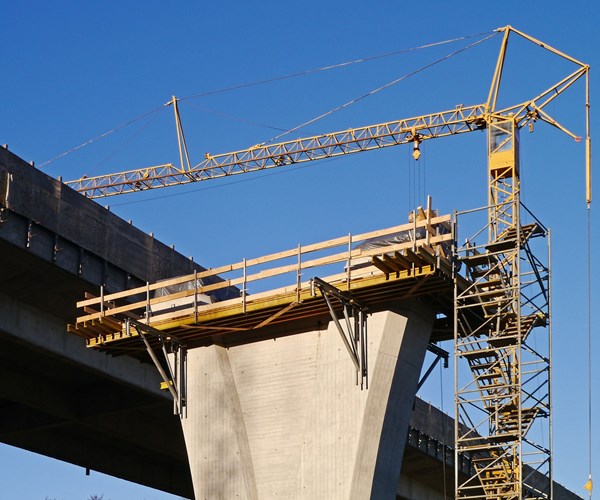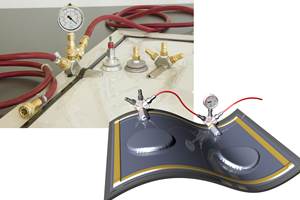Pultruded composites market growing, says EPTA
The European Pultrusion Technology Association (EPTA, Frankfurt, Germany) has published an in-depth report on its highly successful 2018 conference, held in Vienna on March 1-2, 2018. The 12-page document, World Pultrusion Conference 2018: Attractive Long-Term Prospects for Pultruded Composites, is available to download from the EPTA website.

Pultruded composites, discussed at the 2018 EPTA Conference in March, discussed composite rebar as a potential growth area.
The European Pultrusion Technology Association (EPTA, Frankfurt, Germany) has published an in-depth report on its highly successful 2018 conference, which attracted a record number of composites professionals from around the world to Vienna on March 1-2, 2018. The 12-page document, World Pultrusion Conference 2018: Attractive Long-Term Prospects for Pultruded Composites, is available to download from the EPTA website. “This was EPTA's 14th World Pultrusion Conference and it was the biggest event ever,” says Dr. Elmar Witten, EPTA secretary. “The record number of 150 participants, coming from North and South America, Europe, India and South Africa, indicates a clear and growing interest in pultrusion globally. The high level of technology and application development activities showcased in the wide-ranging conference program is evidence of a strong determination to improve the competitiveness of pultruded products and pursue growth opportunities.”
Here are some highlights from the March program, which is presented in greater detail in the full report. A positive long-term future for pultrusion is anticipated in Europe and North America, which account for two-thirds of the global composites market. According to Dan Coughlin, VP of market development at the American Composites Manufacturers Association (ACMA, Arlington, VA, US), pultrusion represents 3% of the total North American end product market for composites and was estimated to be worth $790 million in 2016. Analysts predict a CAGR of approximately 5% to reach $1060 million by 2020, with construction and infrastructure the major growth sectors. Infrastructure growth areas include composite rebar for concrete construction, and an interesting new application, says Mikko Lassila, product business owner, telecommunication, Exel Composites (Mäntyharju, Finland). The company is developing infrastructure and building elements for the forthcoming 5G era, where pultruded glass fiber laminates can be designed to minimize attenuation of the high frequency, short wavelength 5G signals, while also delivering installation and durability benefits. The company is part of the LuxTurrim5G initiative for Smart City Digital Ecosystem Creation, which is developing smart lighting poles designed to create a telecommunications network fit for the world's rapidly growing urban environments. As well as providing energy-efficient lighting and other services, the composite poles will incorporate integrated miniaturized 5G base stations to create a high-capacity 5G data transmission network. The composite pole functions as mast, architectural casing, weather protection and radome for the 5G antenna.
In the area of wind turbines, infusion is currently the dominant technology in spar cap manufacture, says Dr. Rakesh Raj of STRUCTeam Ltd. (Cowes, Isle of Wight, UK) with only around 5% of blades prepreg-based and 5% pultrusion-based. Pultrusion offers a level of quality and lower scrap rates for the structurally-critical spar cap. Pultruded solutions also offer lower overall blade cost versus infusion as well as savings in capital and operating expenditure. The Pullwind consortium – comprising StrucTeam, Olin Corp. (Clayton, MO, US), CPIC (Chongqing, China) and DNV-GL (Oslo, Norway) – has been established to address the challenges associated with the use of pultrusion in blades. For a typical 80 m blade, the Pullwind solution for pultruded spar cap designs enables overall cost savings of 9- 12% and allows for a 10% CAPEX reduction and an overall reduction in blade weight of 3-7%, says the group.
Scott Bader’s (Northamptonshire, UK) Jeffrey Starcher outlined how automotive parts can be custom-pultruded for their application. Potential pultrusion applications include bumper beams, roof beams, front-end support systems, door intrusion beams, chassis rails, and transmission tunnels. His company’s urethane acrylates offer thousands of combinations of resins to choose from, high elongation with high modulus for toughness, and Tg of nearly 300°C. The resins bond extremely well to carbon and glass fiber, deliver snap cure characteristics and pass automotive processing temperatures.
Alongside discussions of market potential, increased productivity was a strong focus of the conference. New pultrusion resins and process technology are being pursued to improve performance over traditional resins such as unsaturated polyester and vinyl ester and enable higher line speeds without affecting properties. Advances in highly reactive resins such as polyurethanes, epoxies and thermoplastics are opening up new possibilities. Polyurethane resins may be the most cost-effective solution for pultrusion. Compared with unsaturated polyester, vinyl ester and epoxy resins, polyurethane offers improved bending strength and higher interlaminar shear strength (ILSS). Working with equipment specialist KraussMaffei, Covestro (Pittsburgh, PA, US) is developing new polyurethane systems designed to enable pultruded polyurethane composites. Dr Paul Heinz, head of Aliphatic Composites, Covestro Deutschland, explained that line speed and coating costs are two of the biggest influences on the cost efficiency of the pultrusion process and so the company has developed resin systems that allow for high line speed and elimination of coating.
Rudolf Emmerich of the Fraunhofer Institute of Chemical Technology (Pfinztal, Germany) presented a new concept for microwave-assisted pultrusion, developed as part of the European Coaline project. Curing time is an important parameter in pultrusion, depending on part wall thickness, and for resins with longer curing times like epoxy and polyurethane. Microwaves offer fast, homogenous or selective heating of materials. Microwave-assisted pultrusion is state of the art but not used in industry primarily because it is necessary to replace the metal die completely with a microwave-transparent ceramic die or partially, with a microwave-transparent ceramic insert. A concept for microwave heating without any major modifications has been developed in which the die geometry is used for transmitting the microwaves, and no ceramic parts are necessary. Retrofit of existing pultrusion dies is possible, says Emmerich.
There’s much more to the report, which is available here at this link: https://pultruders.org/pdf_news/1_WPC%202018%20report_final.pdf. While an older technology, pultrusion has the potential to fit into an automated manufacturing setting given its speed and flexibility.
Related Content
GKN Aerospace, Joby Aviation sign aerostructures agreement
GKN Aerospace will manufacture thermoplastic composite flight control surfaces for Joby’s all-electric, four-passenger, composites-intensive ride-sharing aircraft.
Read MoreCompPair adds swift prepreg line to HealTech Standard product family
The HealTech Standard product family from CompPair has been expanded with the addition of CS02, a swift prepreg line.
Read MorePEEK vs. PEKK vs. PAEK and continuous compression molding
Suppliers of thermoplastics and carbon fiber chime in regarding PEEK vs. PEKK, and now PAEK, as well as in-situ consolidation — the supply chain for thermoplastic tape composites continues to evolve.
Read MoreSmartValves offer improvements over traditional vacuum bag ports
Developed to resolve tilting and close-off issues, SmartValves eliminate cutting through vacuum bags while offering reduced process time and maintenance.
Read MoreRead Next
VIDEO: High-volume processing for fiberglass components
Cannon Ergos, a company specializing in high-ton presses and equipment for composites fabrication and plastics processing, displayed automotive and industrial components at CAMX 2024.
Read MoreAll-recycled, needle-punched nonwoven CFRP slashes carbon footprint of Formula 2 seat
Dallara and Tenowo collaborate to produce a race-ready Formula 2 seat using recycled carbon fiber, reducing CO2 emissions by 97.5% compared to virgin materials.
Read More“Structured air” TPS safeguards composite structures
Powered by an 85% air/15% pure polyimide aerogel, Blueshift’s novel material system protects structures during transient thermal events from -200°C to beyond 2400°C for rockets, battery boxes and more.
Read More






















